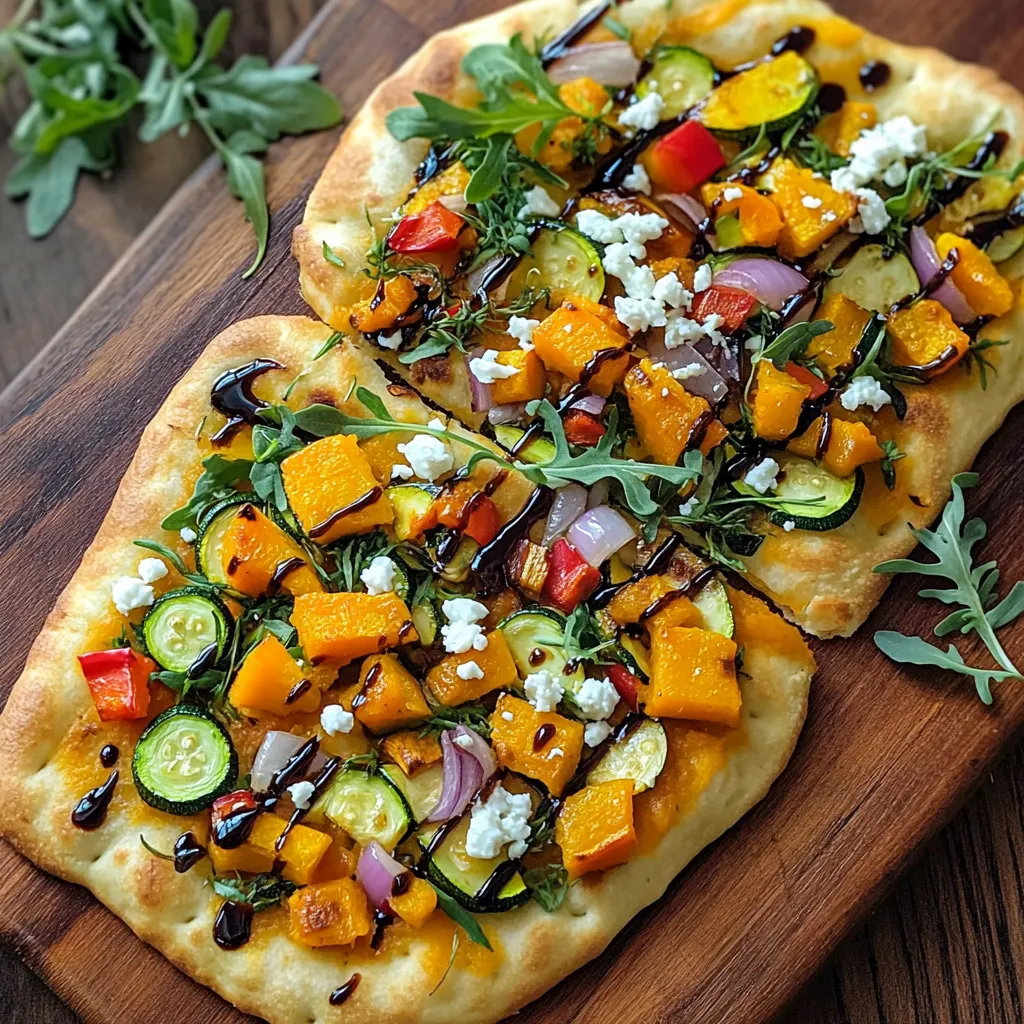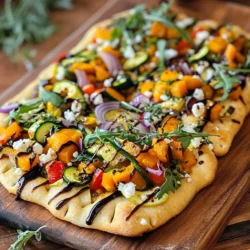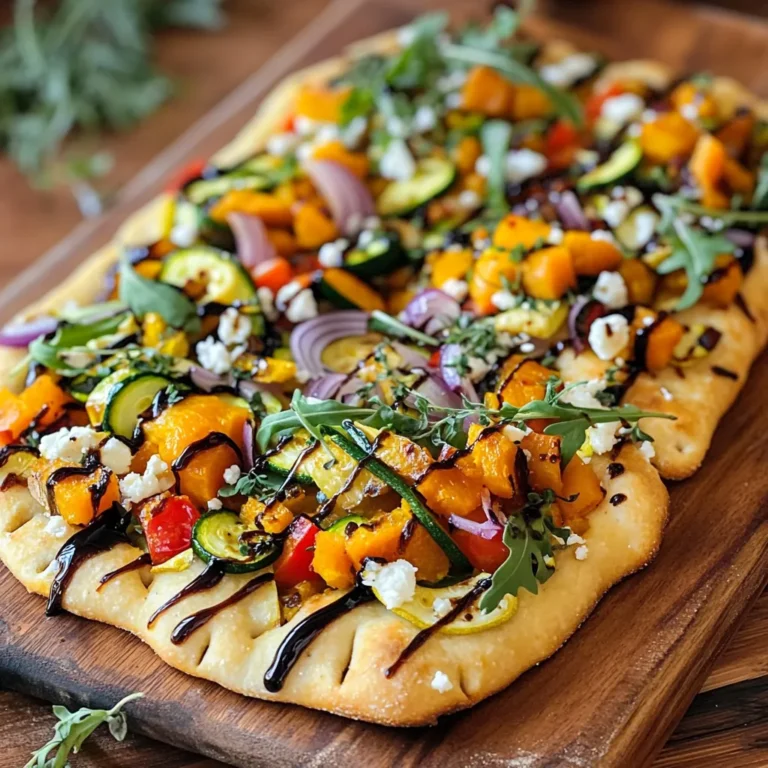If you love fresh flavors and easy cooking, you’re in for a treat! My Harvest Veggie Flatbreads recipe is not only simple to make but also bursting with vibrant veggies. With whole wheat flour and a medley of roasted vegetables, these flatbreads offer a delightful way to enjoy healthy meals. Ready to impress your family and friends? Let’s dive into this tasty recipe and bring a little autumn goodness to your table!
Ingredients
List of Ingredients
- 2 cups whole wheat flour
- 1 teaspoon salt
- 1 teaspoon baking powder
- 3/4 cup water (adjust as needed)
- 1 tablespoon olive oil
- 1 cup butternut squash, roasted and diced
- 1 red bell pepper, diced
- 1 zucchini, sliced
- 1/2 red onion, thinly sliced
- 1 cup arugula
- 1/2 cup crumbled feta cheese
- 2 tablespoons balsamic glaze
- Fresh thyme leaves for garnish
When I make these flatbreads, I start with whole wheat flour. It gives a nice nutty flavor. Then, I add salt and baking powder. These help the dough rise and taste good. I mix in water and olive oil to bind it all together.
Next, I focus on the fresh vegetables. I love using roasted butternut squash. It adds sweetness and warmth. Diced red bell pepper and sliced zucchini bring color and crunch. I also include thinly sliced red onion for a bit of zing.
For toppings, I layer fresh arugula and crumbled feta cheese on top. The feta adds a creamy, salty bite that contrasts with the soft veggies. I finish each flatbread with a drizzle of balsamic glaze. This adds a sweet-tart flavor that brightens the dish. Finally, I sprinkle fresh thyme leaves for an extra touch of freshness.
These ingredients come together to create a delicious and colorful meal. Once you gather them, you are ready to make something special!
Step-by-Step Instructions
Making the Flatbread Dough
Combine Dry Ingredients
In a large bowl, mix 2 cups of whole wheat flour, 1 teaspoon of salt, and 1 teaspoon of baking powder. This mix gives your flatbread a nice flavor and texture.
Add Wet Ingredients
Next, slowly add 3/4 cup of water and 1 tablespoon of olive oil. Stir with a fork until the dough starts to come together.
Kneading and Resting the Dough
Knead the dough for about 5 minutes. It should feel smooth and soft. Then, cover it with a damp cloth. Let it rest for 30 minutes. This helps the dough become easier to roll.
Roasting the Vegetables
Oven Temperature and Preparation
Preheat your oven to 400°F (200°C). This hot oven gives the veggies a nice roast.
Roasting Process for Each Vegetable
On a baking sheet, spread 1 cup of diced butternut squash and 1 sliced zucchini. Drizzle with olive oil and sprinkle with salt. Roast these for 20-25 minutes. After 10 minutes, add 1 diced red bell pepper and 1/2 thinly sliced red onion. They will roast for the last 10 minutes.
Rolling and Cooking the Flatbreads
Dividing the Dough
After resting, divide the dough into 4 equal pieces. Each piece will be a flatbread.
Cooking Techniques and Tips
On a floured surface, roll each piece into a thin flatbread, about 1/4 inch thick. Heat a non-stick skillet or cast-iron griddle on medium-high heat. Cook each flatbread for 2-3 minutes on each side until golden and slightly puffed. Keep them warm after cooking.
Assembling the Flatbreads
Layering Vegetables and Toppings
On each flatbread, layer the roasted veggies evenly. Then, add a handful of fresh arugula and 1/2 cup of crumbled feta cheese.
Presentation Suggestions
Drizzle each flatbread with balsamic glaze and sprinkle with fresh thyme leaves. For a great look, serve them on a rustic wooden board with extra thyme and balsamic glaze on the side.
Tips & Tricks
Perfecting the Flatbread Texture
Kneading Techniques
Kneading the dough is key for great flatbreads. Use your palms to push down and fold the dough. This helps develop gluten, which gives the flatbread a nice chew. Knead for about five minutes until the dough feels smooth and elastic.
Adjusting Consistency
If your dough is too sticky, add a little flour. If it’s too dry, add water a tablespoon at a time. The right texture should be soft but not wet. This balance is crucial for cooking evenly.
Flavor Enhancements
Alternative Herbs and Seasonings
You can switch up the taste with different herbs. Try rosemary, oregano, or basil for a fresh twist. A pinch of garlic powder can also add flavor. Experiment to find your favorite mix!
Cheese Substitutions
If you want a different cheese, feta is great, but try goat cheese or ricotta too. These cheeses melt well and add nice flavors to the flatbread. Each choice changes the dish in a new way.
Serving Suggestions
Pairing with Dips and Sides
Serve your flatbreads with hummus, tzatziki, or a fresh dip. A side salad with lemon vinaigrette pairs nicely too. These sides enhance the meal and add more colors to your plate.
Ideal Dining Settings
These flatbreads are perfect for casual meals or a fun gathering. They work well for family dinners or picnics. Set them on a wooden board for a rustic look and let everyone dig in together!

Variations
Seasonal Vegetable Options
What are the best vegetables for each season?
In spring, use fresh asparagus and peas. Summer is great for ripe tomatoes and sweet corn. In fall, try roasted butternut squash and Brussels sprouts. Winter calls for hearty root vegetables like carrots and parsnips. These seasonal veggies add flavor and nutrition.
What are some creative combinations?
Mix roasted sweet potatoes with kale for a hearty bite. Pair zucchini and red bell pepper for a vibrant touch. You can also combine roasted eggplant with fresh herbs for a unique twist. Let your imagination guide you!
Dietary Modifications
What are gluten-free flatbread alternatives?
You can use almond flour or chickpea flour. Both create a tasty base. Try using gluten-free all-purpose flour for a simple swap. Just adjust the water amount for the dough.
What are vegan topping ideas?
Skip the feta cheese and use avocado or hummus. You can also use nutritional yeast for a cheesy flavor. Top with fresh herbs, like basil or cilantro, for extra zest.
Incorporating Different Flours
How can I use alternative grains?
Try using oat flour or spelt flour for a different taste. Each grain gives a unique flavor and texture to your flatbread. Experiment to find what you love best.
What effects do different flours have on flavor and texture?
Whole wheat flour gives a nutty flavor and hearty texture. Almond flour adds moisture and a slight sweetness. Each flour changes the flatbread, so don’t be afraid to mix and match!
Storage Information
Best Practices for Storing Flatbreads
To keep your harvest veggie flatbreads fresh, store them properly. First, let the flatbreads cool completely. Wrap each flatbread in plastic wrap or foil. Place them in an airtight container. You can store them in the fridge for up to five days. If you want to keep them longer, freeze them. Lay flatbreads in a single layer in a freezer-safe bag. They will last up to three months in the freezer.
Reheating Instructions
When it’s time to enjoy your flatbreads again, reheating them right is key. You can use a skillet or an oven. For a skillet, heat it over medium heat. Add the flatbread and cook for about 2 minutes on each side until warm. If using an oven, preheat it to 350°F (175°C). Wrap the flatbreads in foil and heat for about 10 minutes. This keeps the texture nice and soft.
Shelf Life and Resealing
Your flatbreads will last for about five days in the fridge if stored well. In the freezer, they can last up to three months. Check for any signs of spoilage. If you see mold or an off smell, it’s best to throw them away. Reseal your storage containers each time you take a flatbread out. This helps keep the rest fresh and tasty.
FAQs
How to make flatbreads from scratch?
To make flatbreads from scratch, mix 2 cups of whole wheat flour, 1 teaspoon of salt, and 1 teaspoon of baking powder in a bowl. Then, slowly add 3/4 cup of water and 1 tablespoon of olive oil. Mix until a dough forms. Knead the dough for about 5 minutes until it feels smooth. Let it rest for 30 minutes under a damp cloth.
What vegetables are best for harvest flatbreads?
Harvest flatbreads shine with seasonal veggies. Great choices include:
- Butternut squash
- Red bell peppers
- Zucchini
- Red onions
- Arugula for freshness
These veggies add color and flavor, making your flatbreads delicious.
Can I prepare the dough ahead of time?
Yes, you can prepare the dough ahead of time. After kneading the dough, wrap it in plastic. Store it in the fridge for up to 24 hours. This method saves time when you’re ready to cook.
How do I know when the flatbreads are cooked properly?
Cook the flatbreads for about 2-3 minutes on each side. They should turn golden and puff up slightly. Check for a nice, crisp texture when they are done.
Is this recipe suitable for meal prep?
Absolutely! You can make these flatbreads for meal prep. Store cooked flatbreads in an airtight container. They last well in the fridge for up to 3 days. Reheat them in a skillet for the best taste.
Making flatbreads from scratch is fun and easy. We covered all the key steps, from mixing fresh ingredients to roasting veggies. I shared tips on texture and flavor to help you create a perfect dish. Remember, experimenting with different vegetables and toppings gives your flatbreads a fresh twist. Store them right, and they’ll last longer. Enjoy making this simple, tasty flatbread and impress your friends and family!


